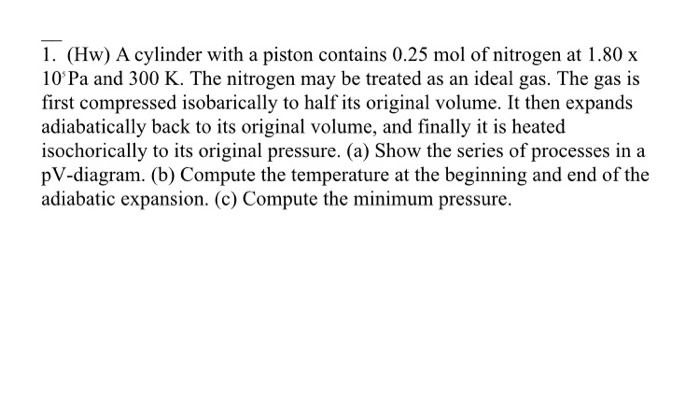1. (Hw) A cylinder with a piston contains 0.25 mol of nitrogen at 1.80 x 10'Pa and 300 K. The nitrogen may be treated as an ideal gas. The gas is first compressed isobarically to half its original volume. It then expands adiabatically back to its original volume, and finally it is heated isochorically to its original pressure. (a) Show the series of processes in a pV-diagram. (b) Compute the temperature at the beginning and end of the adiabatic expansion. (c) Compute the minimum pressure.
1. (Hw) A cylinder with a piston contains 0.25 mol of nitrogen at 1.80 x 10'Pa and 300 K. The nitrogen may be treated as an ideal gas. The gas is first compressed isobarically to half its original volume. It then expands adiabatically back to its original volume, and finally it is heated isochorically to its original pressure. (a) Show the series of processes in a pV-diagram. (b) Compute the temperature at the beginning and end of the adiabatic expansion. (c) Compute the minimum pressure.
Principles of Instrumental Analysis
7th Edition
ISBN:9781305577213
Author:Douglas A. Skoog, F. James Holler, Stanley R. Crouch
Publisher:Douglas A. Skoog, F. James Holler, Stanley R. Crouch
Chapter2: Electrical Components And Circuits
Section: Chapter Questions
Problem 2.12QAP
Related questions
Question

Transcribed Image Text:1. (Hw) A cylinder with a piston contains 0.25 mol of nitrogen at 1.80 x
10'Pa and 300 K. The nitrogen may be treated as an ideal gas. The gas is
first compressed isobarically to half its original volume. It then expands
adiabatically back to its original volume, and finally it is heated
isochorically to its original pressure. (a) Show the series of processes in a
pV-diagram. (b) Compute the temperature at the beginning and end of the
adiabatic expansion. (c) Compute the minimum pressure.
Expert Solution
This question has been solved!
Explore an expertly crafted, step-by-step solution for a thorough understanding of key concepts.
This is a popular solution!
Trending now
This is a popular solution!
Step by step
Solved in 4 steps with 1 images

Knowledge Booster
Learn more about
Need a deep-dive on the concept behind this application? Look no further. Learn more about this topic, chemistry and related others by exploring similar questions and additional content below.Recommended textbooks for you

Principles of Instrumental Analysis
Chemistry
ISBN:
9781305577213
Author:
Douglas A. Skoog, F. James Holler, Stanley R. Crouch
Publisher:
Cengage Learning

Principles of Instrumental Analysis
Chemistry
ISBN:
9781305577213
Author:
Douglas A. Skoog, F. James Holler, Stanley R. Crouch
Publisher:
Cengage Learning